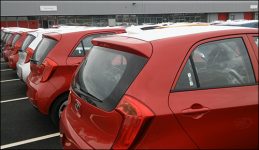
RFID technology helps improve the processing and transportation efficiency of Kia Motors
[ad_1]
British logistics provider Paragon Automotive deployed an RFID solution to track Kia cars near the port of Immingham, where these cars were painted, stored and shipped to other retail locations. The system uses Paragon’s own management software, mobile and fixed readers, and attaches EPC Gen2 passive UHF RFID tags to the car. RFID technology can help Paragon meet the requirements of the large and growing British automotive market.
Last year, Kia opened a 35-hectare facility in Stallingborough to receive foreign-produced cars, sort them and transport them to retail locations in the UK. Paragon also provides on-site vehicle storage and finishing services. The car service company also installed an RFID system to increase visibility of car inventory, thereby increasing efficiency. Paragon also provides old car refurbishment services or new car finishing services for automakers. In addition, the company also provides port operation services, including preparing vehicles according to customer requirements, storing them in a safe outdoor environment, and delivering them. The company provides services for 750,000 old and new vehicles every year.

(Kia cars marked with tags are all parked in Paragon storage)
Paragon said the market for new cars is growing. The number of new cars sold in the UK last year reached 2.63 million. The import of these cars has also put a lot of pressure on car manufacturers and their logistics providers. The new port parks 20,000 new cars every year and more than 100,000 cars every year.
Chris Higgins, Paragon’s group IT manager, said tracking the location of these cars is a time-consuming process. In fact, the inventory check of 20,000 vehicles requires 20 employees to complete a full week. In addition, there are no license plates on these new cars, which is also difficult to identify.
In addition, the operator needs to find the location of the car before finishing, and usually needs to manually input the location to view the location of the vehicle information. Each car is stored in a specific rank. The format of the address record is “row AA, column 22”. Every time employees need to use Android handheld devices to manually record the car’s location and the car’s vehicle identification number (VIN).
Higgins said: “We do recognize that RFID can simplify the process and improve our efficiency.” The technology can also be used to identify vehicle locations or redistribute empty locations. The company searches for vehicles based on regional data and industry address information in the software. He said that employees can also use handheld readers to identify vehicles without having to enter the last 8 digits of the VIN number.
A few years ago, Paragon began to consider the use of active RFID tags in some locations to provide real-time location visibility. However, Higgins claims that the cost of attaching an active tag to each vehicle is too high. In February 2015, the company began to invest in UHF RFID tags. He said: “We found that this is a better method of inventory control and tracking.”

(Paragon attaches a Smartrac DogBone tag to the inside of the rear glass in each vehicle and binds the tag ID to the vehicle VIN number)
After the car was unloaded on the ship, Paragon attached a Smartrac DogBone tag to the inside of the rear glass of each vehicle and bound the tag ID to the vehicle’s VIN number. Then, the operator drove the car into the Kia parking lot, where Paragon installed 24 Zebra FC series readers, and transmitted the read tags to the Kia IT platform to remind the Kia vehicle to have received it. This information will be provided to traders through Kia’s IT platform.
Paragon also designed Evolution software to collect RFID tag reading data and transmit it to Kia IT platform and Paragon management system, and use Telerik software to display these data.
While transmitting the read data to Kia, the Evolution software will recognize the vehicle, confirm its location and display it on the automatic information board, instructing the driver to pick up the vehicle. Readers are also installed at key locations (storage area gates and pivot points) to identify the location of specific vehicles.
In addition, readers are also installed at the entrance of the workshop and pre-shipment inspection (PDI) area. In this way, the system knows the finishing time of the finishing work, and this information will be stored in the software.
In each workshop, the screen will inform the technician what specific service is needed (such as changing or removing the cushion, or adding a drag bar or decal) so that he can complete the required service and deliver it to the next designated location.
Higgins said: “This helps us to track abnormalities, such as: the vehicle has not completed the required processing tasks but has left the workshop. In this case, the software will display a warning on the screen as a reminder.”

(A reader antenna is installed at the entrance of Paragon and connected to the Zebra FX series RFID reader)
In order to accurately locate the location of the vehicle in the storage area and provide additional inventory counting, Paragon installed an RFID reader on the roof of the pickup truck. When the pickup is moved in the outdoor storage area, the reader will read the ID number of the vehicle, and the data will be transmitted to the Evolution software along with the GPS location.
Higgins explained: “This can provide us with a recent date, time and GPS location.” The company also integrated the location into the Mapbox open source software to provide accurate location information in the form of images.
Finally, when the car is loaded on a pickup truck and transported to the dealer, Paragon will install 2 sets of fixed readers at the gate to read the tag data. The software will read and store the read data, and compare it again to ensure that no errors occur.
[ad_2]




